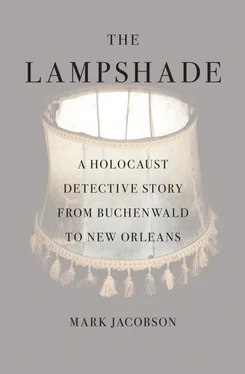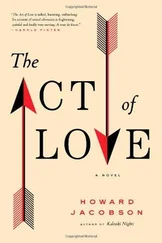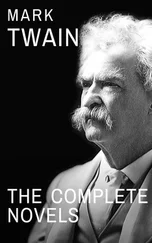Only a few blocks from here, on January 15, 1933, days before becoming chancellor, Hitler addressed ten thousand cheering people in the Marktplatz in front of the Hotel Elephant. Those were the Nazis I knew, chinstrap-straight Aryans in the thrall of their master’s voice. Also recognizable would have been those twenty-two skinheads and their fraus who, on July 24, 1994, according to an Associated Press account, attacked the Buchenwald camp “shouting ‘Sieg Heil,’ giving the stiff-armed Hitler salute, and threatening to burn ‘with their own hands’ a woman who works at the camp.”
But as for the young men in front of me, it was hard to tell. Sometimes present-day Nazis announce themselves with brand loyalty to their preferred gegen, or fighting apparel. Favorites are Thor Steinar and Lonsdale—the latter a familiar soccer club T-shirt logo that, with a jacket worn over it, can be arranged so only the letters N, S, and D show, for Nationalsozialistische Deutsche . On Lisztstrasse, however, these self-signifiers were nowhere in sight. Under the streetlights the Nazis presented as merely generic-looking punks, black hoodies pulled down over the brims of baseball hats, low-slung jeans, Chuck Taylor Converse sneakers. At this distance it was nearly impossible to distinguish them from the “antifa,” or “antifascist” left-wing youth, who also wear black hoodies, low-slung jeans, and Converse.
“This is because there is the antifa and the anti -antifa, two sides of a coin,” I would later be told by a man who chose to call himself Hans, which he said was “a perfect German name, straight from the earth, dripping with blood, soil, and beer.”
Raised in “a big, soft-with-money Nazi family” in West Germany, as a teenager Hans found himself more at home with the disgruntled youth in the shabby outlying neo-Stalinist housing projects in East Berlin “Ossie” suburbs like Marzahn and Lichtenberg.
“It started with the music,” Hans said. “Real good hard-core fuck-the-world music. I wanted to know how they felt, to be at the bottom of the barrel, unloved and wondering why. I saw how it worked with these people. Their parents filled their heads with the commie bullshit. At school was the reunification bullshit. The TV had the American buy-this, buy-that bullshit. But over there, in the corner, was Grandpa. He was an old man now, sick. No one paid much attention to him. But he once was a Wehrmacht soldier, a defender of the Reich. Smart in his uniform on the bloody front. And when he talked about those days, it was not bullshit. It was about another time, when there was something to believe in, when the world was there for the taking.
“I felt, this makes sense,” said Hans, who joined up with a variety of hard-right groups. “I stayed with them for years but could not continue. Maybe I wasn’t desperate enough, maybe it became clear that the right wing politicians were as corrupt as anyone else. Maybe I met some of those people I was supposed to hate, even Jews, and I found they weren’t all the same like I’d thought. I even liked some of them. But mostly it was the violence. I didn’t want to walk into a room blind drunk and be helpless to stop my finger from pulling a trigger as I shouted, ‘Heil Hitler.’ ”
Now entering his thirties, long frizzed mullet grown onto his formerly shaved skull, Hans said it was the “stupidity of the state” that gave the right-wing anti-antifa no choice but to dress in the exact same way as the left-wing antifa.
“The Hakenkreuz and everything else are banned,” Hans explained. “If you are seen with a swastika, you are put in jail. So it is best to go out dressed plainly.” At first many of the right-wing youth resented this curtailment of their so-called self-expression, but they soon realized this “plain dress” annoyed the left-wing youth.
“When we heard the antifa were in their bars and squats, angry that we were supposed to be copying them, that was great. Anything that made them mad, the stupid arrogant fuckers. If the antifa made a decal saying, ‘Good Night, White Pride,’ with cartoons in the middle, the anti-antifa made the same thing with ‘Good Night, Left Side’ and Mario from Donkey Kong in the middle.”
It made sense, Hans said, because when it came to the most militant members of the antifa and the anti-antifa, there wasn’t all that much difference between the two. “They all hate capitalism, say they will do anything to save the planet from big business and pollution, and want Israel blown off the map. They might have completely different reasons, but this is what they want. But what they really want to do is fight. Punch each other in the head.”
There was one sure way to tell the difference between the antifa and anti-antifa, Hans said, pulling up the sleeves of his sweatshirt. “You look at the skin. Then you know.”
He was covered with tats, had at least twenty, he said. On his arms was some of the typical Nazi stuff, a Celtic cross along with other runic geometry, and a bunch of gothic-lettered tributes to black metal bands including “an old one” honoring Absurd, whose leader, Hendrik Möbus, was jailed following a pilgrimage to West Virginia, where he was photographed exchanging Hitler salutes with late white nationalist William Pierce, author of the apocalyptic Nazi novel The Turner Diaries . On his back, Hans said, he had a six-inch-wide swastika and the head of Geronimo, owing to his longtime infatuation with Native Americans, whom he regarded as more legitimate pagan souls than the greasy-bearded Wotanists revered by most neo-Nazis. Running his hand over the black sun imprinted on his forearm, Hans said it was a problem, what to do with these things once you stopped believing in them.
Talk of tattoos got us onto the lampshade. Hans said lampshades were something of a coming thing in the German right-wing underground. He still had contacts around the black metal music scene, where “you hear people go on about lampshades, getting their hands on one. Buying one or even making them.” Not that Hans believed this was anything more than “big talk.” Personally he’d never seen a lampshade, even a fake, and that was okay since the whole idea gave him “the creeps.”
“Maybe that’s what we’re all doing,” Hans allowed with a shrug, pulling down his sleeves. “Preparing ourselves to be made into lampshades.”
As for the Nazis in Weimar, I need not have worried about them, Hans said. “They wouldn’t have known you in a thousand years.”
This was true. After all, my nose is big, a definite honker, but it isn’t that big; it doesn’t quite hook like the Shylock beaks in Goebbels’s Expressionist propaganda posters. Nor was I hunched over like an insect under a soiled prayer shawl. I held no visible puppet strings by which I controlled the reins of international capital. In 1937 the race scientists at nearby Jena University might have applied their phrenological calipers to my cranium, so as to suss out my dirty secret. In bathrooms, storm troopers bearing bright gooseneck lamps would have homed in on my foreskinlessness, pointing with black-gloved fingers at the undeniable proof. But this being now I could pass. The approaching neo-Nazis might know chapter and verse of every Elder of Zion conspiracy, but it was all abstraction, stuff pulled off the Internet from right-wing sites in America. Seinfeld was on the TV, but how many real Jews had these would-be Übermenschen really seen, in the flesh? There were never very many Jews in Thuringia to begin with, and the original Nazis had managed to reduce that number from an estimated 4,500 to 450. In the GDR, if Jews appeared in the history books at all, it was as “victims,” a “victim” being the lowest of concentration camp inmates, below “resistance fighters” and passive “mere survivors.” It was a pejorative thing, to be called “a victim.” Neo-Nazis often addressed their targets as “you victim” before stomping them.
Читать дальше












